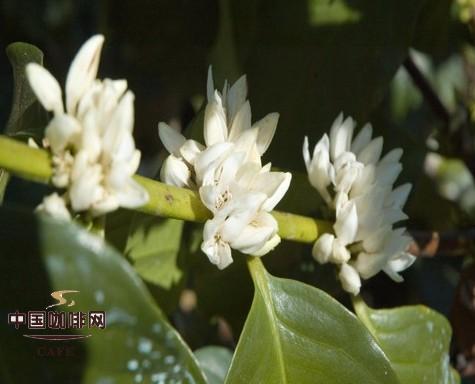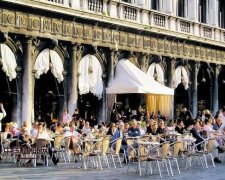The flowering aroma of coffee fruit the source of real caffeine aroma.

In a coffee obsession like mine, there is no smell comparable to the smell in the coffee field during the flowering period. The first flowering period of the coffee tree is about three years. The white flowers are five-petal tube-shaped flowers, with a faint fragrance of jasmine, and the inflorescences are arranged in dense clusters. It will wither after two or three days of flowering and begin to bear fruit after a few months. In Yunnan, this period coincides with the beginning of the rainy season, usually in March or April, when the climate is drier and temperatures begin to rise, when Rain Water breaks open sleeping buds. These blooming coffee flowers are of great significance for the upcoming coffee ripening season.
90-95% of Arabica coffee trees are self-pollinated: the pollen that pollinates the flowers comes from the same plant, and the berries begin to develop immediately. The fruit is a drupe with a diameter of about 1.5 centimeters. depending on the variety, the berries change from green to yellow or red as they mature. Because the flowering time is scattered back and forth, you will see red and green berries hanging on the tree. Coffee fruit contains two seeds, namely coffee beans. The two beans are connected face to face with each other on one side of the plane.
The time required from flowering to coffee berry ripening is affected by several factors, including coffee varieties, climatic conditions and agronomic practices. For Arabica coffee, it takes about 6-9 months, which means it can be harvested in Yunnan from then on. The harvest season for the coffee belt begins in October (September in some warmer areas) and lasts until February next year. Although mechanized picking can be used when conditions permit, most countries still pick coffee fruits by hand.
Manual picking is a labor-intensive operation with high cost. Therefore, it is mainly used to pick high-quality Arabica coffee beans. This is only the first step in the production of high-quality coffee, and it is also the way to pick coffee in Yunnan. Fresh fruit needs to be peeled on the day of picking, followed by fermentation, cleaning and drying to ensure that the coffee beans maintain the purest and original aroma and taste.
When high-quality coffee beans are picked, the most important step in making them gourmet coffee is roasting and mixing. As a result, coffee beans from different places show different fragrant, dry, mellow, bitter and sour tastes. A master baker must have the temperament of an artist and the rigor of a scientist. Only in this way can we ensure that the sugars and other carbohydrates in the coffee are carbonized during the baking process, thus producing the well-known coffee fat and producing good coffee of high quality and consistent style. Academically, this subtle chemical is not really grease (because it is soluble in water), but it is the source of the aroma of coffee. Professional coffee is generally roasted in small batches. Different degrees of roasting of coffee beans determine what flavor the coffee beans will eventually show. The aroma extracted from coffee beans is proportional to the baking time, the deeper the roasting degree, the less caffeine content and the less acidity. The deeper the baking, the more scorched you taste and the lighter the taste of the coffee bean itself.

In a coffee obsession like mine, there is no smell comparable to the smell in the coffee field during the flowering period. The first flowering period of the coffee tree is about three years. The white flowers are five-petal tube-shaped flowers, with a faint fragrance of jasmine, and the inflorescences are arranged in dense clusters. It will wither after two or three days of flowering and begin to bear fruit after a few months. In Yunnan, this period coincides with the beginning of the rainy season, usually in March or April, when the climate is drier and temperatures begin to rise, when Rain Water breaks open sleeping buds. These blooming coffee flowers are of great significance for the upcoming coffee ripening season.
90-95% of Arabica coffee trees are self-pollinated: the pollen that pollinates the flowers comes from the same plant, and the berries begin to develop immediately. The fruit is a drupe with a diameter of about 1.5 centimeters. depending on the variety, the berries change from green to yellow or red as they mature. Because the flowering time is scattered back and forth, you will see red and green berries hanging on the tree. Coffee fruit contains two seeds, namely coffee beans. The two beans are connected face to face with each other on one side of the plane.
The time required from flowering to coffee berry ripening is affected by several factors, including coffee varieties, climatic conditions and agronomic practices. For Arabica coffee, it takes about 6-9 months, which means it can be harvested in Yunnan from then on. The harvest season for the coffee belt begins in October (September in some warmer areas) and lasts until February next year. Although mechanized picking can be used when conditions permit, most countries still pick coffee fruits by hand.
Manual picking is a labor-intensive operation with high cost. Therefore, it is mainly used to pick high-quality Arabica coffee beans. This is only the first step in the production of high-quality coffee, and it is also the way to pick coffee in Yunnan. Fresh fruit needs to be peeled on the day of picking, followed by fermentation, cleaning and drying to ensure that the coffee beans maintain the purest and original aroma and taste.
When high-quality coffee beans are picked, the most important step in making them gourmet coffee is roasting and mixing. As a result, coffee beans from different places show different fragrant, dry, mellow, bitter and sour tastes. A master baker must have the temperament of an artist and the rigor of a scientist. Only in this way can we ensure that the sugars and other carbohydrates in the coffee are carbonized during the baking process, thus producing the well-known coffee fat and producing good coffee of high quality and consistent style. Academically, this subtle chemical is not really grease (because it is soluble in water), but it is the source of the aroma of coffee. Professional coffee is generally roasted in small batches. Different degrees of roasting of coffee beans determine what flavor the coffee beans will eventually show. The aroma extracted from coffee beans is proportional to the baking time, the deeper the roasting degree, the less caffeine content and the less acidity. The deeper the baking, the more scorched you taste and the lighter the taste of the coffee bean itself.
Important Notice :
前街咖啡 FrontStreet Coffee has moved to new addredd:
FrontStreet Coffee Address: 315,Donghua East Road,GuangZhou
Tel:020 38364473
- Prev

Innovative formula of fancy coffee Chinese-style wine combined with western-style coffee
In the history of coffee, there is no shortage of coffee drinks mixed with western wine, but Chinese wine combined with western-style coffee, and officially launched for the market, is still the first in the industry: daughter red coffee? What kind of taste is this? Or, in the bookstore with a strong flavor of Chinese traditional culture, the smell of scholarly coffee, time travel, the combination of Chinese and Western, delicious more wonderful. Pacific Coffee (Pacific Coffee)
- Next

The development process of coffee fruit Vienna's "coffee center"
On Montsio Street in Barcelona, I found the Four Cats Cafe, where tourists stopped at the entrance to examine the cafe's small front door and the poster of Ramon Casas, and a middle-aged woman guided them to their seats, giving a very brief history of the cafe. Many tourists come for Picasso. 1899, age 17.
Related
- Beginners will see the "Coffee pull flower" guide!
- What is the difference between ice blog purified milk and ordinary milk coffee?
- Why is the Philippines the largest producer of crops in Liberia?
- For coffee extraction, should the fine powder be retained?
- How does extracted espresso fill pressed powder? How much strength does it take to press the powder?
- How to make jasmine cold extract coffee? Is the jasmine + latte good?
- Will this little toy really make the coffee taste better? How does Lily Drip affect coffee extraction?
- Will the action of slapping the filter cup also affect coffee extraction?
- What's the difference between powder-to-water ratio and powder-to-liquid ratio?
- What is the Ethiopian local species? What does it have to do with Heirloom native species?

